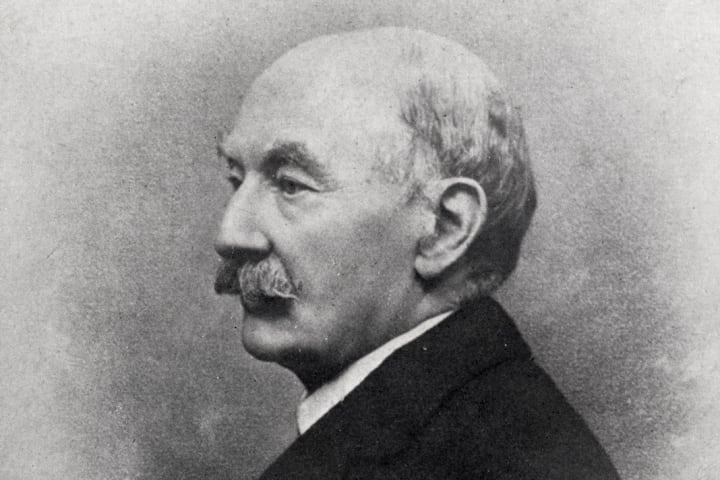Every so often the literary world is rocked by the discovery of a work that was thought to be lost forever. Take, for instance, Percy Bysshe Shelley’s “Poetical Essay on the Existing State of Things”: The work, published in 1811, was attributed to the author in 1872 (50 years after he had died) and rediscovered in 2006. But there are many books that remain lost to this day, much to the sadness of readers everywhere. Here are 11 of the most tragic literary losses—excluding, of course, the countless texts which have been wiped from the record so thoroughly that there’s no evidence they ever existed.
Robert Louis Stevenson / adoc-photos/GettyImages
There are two versions of the story about what happened to Robert Louis Stevenson’s first draft of The Strange Case of Dr Jekyll and Mr Hyde (1886), but both end in fire.
While suffering from what may have been tuberculosis and taking cocaine (which at that time was prescribed as medicine), Stevenson supposedly wrote the draft of the novella in just three days. When his wife Fanny read it, she said that he had “missed the allegory,” causing Stevenson to toss the pages into the fire. He then frantically rewrote the manuscript in another three days.
Or so goes the version told by his stepson Lloyd Osbourne. The alternative story is that Fanny herself burned the draft. It was, she wrote in a letter to a friend, “a quire full of utter nonsense,” declaring, “I shall burn it after I show it to you.” Regardless of who was responsible for casting the pages into the flames, Stevenson’s initial take on his now-iconic character is gone forever.
In 2013, Oxford English Dictionary chief bibliographer Veronica Hurst was verifying the entry for revirginize when she encountered a problem: She couldn’t locate a copy of the book that the word was cited as coming from. Meanderings of Memory (1852), written under the pseudonym Nightlark, is the earliest known source of 51 words—but other than an entry in a bookseller’s catalog, the OED had no leads on the mysterious book.
The dictionary put out a public appeal in a bid to find a copy. The handwriting on the original submission slip was subsequently identified by OED editor Peter Gilliver as that of Edward Peacock, an antiquarian who lived in Lincolnshire; a member of the public also turned up another reference to the book in a Sotheby’s catalogue from 1854.
Hurst, who believes the book is likely a poetry collection, told the Los Angeles Times that “one theory is that it could be pornographic, or in some ways a clandestine publication that didn’t get recorded in the normal way.” So far, no copy of Nightlark’s book has been found.
At the time of her death in 1963, Sylvia Plath had been working on a semi-autobiographical novel about a woman whose husband is unfaithful. First titled The Interminable Loaf, then Doubletake, and finally Double Exposure, the novel was inherited, along with the rest of her estate, by her husband Ted Hughes, from whom she had separated in 1962. What happened to it next is unclear.
In the preface to Plath’s posthumously published Johnny Panic and The Bible of Dreams (1977) Hughes wrote that she had “typed some 130 pages” but that “the manuscript disappeared somewhere around 1970.” But in a 1995 interview with The Paris Review he told a different story: “Her mother said she saw a whole novel, but I never knew about it. What I was aware of was sixty, seventy pages which disappeared. And to tell you the truth, I always assumed her mother took them all.” These differing stories, coupled with the fact that Hughes had previously copped to destroying one of Plath’s notebooks because “I did not want her children to have to read it,” raised suspicions that he may have also disposed of Double Exposure.
While there is a chance that Double Exposure will be discovered one day, as sections of her earlier novel Falcon Yard were (that manuscript was burned by Plath herself), the possibility that nothing remains to be discovered also exists.
Since 2007, Wikipedia has been the largest encyclopedia ever compiled; the previous holder of this record was the Yongle Encyclopedia, completed in 1408. The Yongle Emperor of the Ming dynasty employed 2169 scholars to collect knowledge from all over China, encompassing subjects like history, geography, astronomy, and philosophy. The project amounted to 11,095 volumes.
The Jiajing Emperor, fearing the loss of the Yongle Encyclopedia, commissioned a copy that was completed in 1567, at the beginning of the reign of the Longqing Emperor. The original work was lost soon afterwards (exactly how isn’t known), but the copy survived largely intact until 1860, when British and French soldiers were ordered to sack the Old Summer Palace in Beijing during the Second Opium War, leading to many of the volumes being stolen or burned. The volumes continued to dwindle over the years, and now only about 3.5 percent—less than 400 volumes—of the encyclopedia remain. Although volumes are occasionally found, such as the one discovered at The Huntington Library in California in 2014, it’s highly unlikely that substantial portions of it will ever be recovered.

Terry Pratchett. / Phil Walter/GettyImages
Fantasy author Terry Pratchett, best known for his Discworld series, requested that his unfinished works be destroyed when he died. As fellow author Neil Gaiman recounted, Pratchett told him that he wanted “whatever he was working on at the time of his death to be taken out along with his computers, to be put in the middle of a road and for a steamroller to steamroll over them all.” And that’s exactly what happened in 2017, two years after his death: During the Great Dorset Steam Fair that year, an antique steamroller was used to crush Pratchett’s hard drive. Rob Wilkins, Pratchett’s long-term assistant and business manager, told BBC Breakfast that he had been working on “10 titles I know of and fragments from many other bits and pieces.”
Approximately 543 English plays performed in commercial playhouses during the Renaissance have survived. That may seem like a large number, but according to David McInnis, an associate professor at the University of Melbourne,“as many as 744 plays are identifiably lost, with hundreds more completely untraceable.” One of the most famous lost plays is William Shakespeare and John Fletcher’s The History of Cardenio, which was performed in 1613 and entered into The Stationers’ Register, a record that listed publishing rights, in 1653. It’s assumed that it was based on part of Miguel de Cervantes’s Don Quixote, which features a character called Cardenio.
In 1727, editor and Shakespeare imitator Lewis Theobald staged a play called Double Falsehood, which was based on three untitled manuscripts Theobald claimed were the lost Cardenio. The next year, he published an edition of the play—but at some point, the manuscripts vanished and were ultimately never verified. While some academics have taken Theobald’s play at face value, others are skeptical of its authenticity. As Oxford University professor Tiffany Stern told the BBC, “If you look for Shakespeare in the work of a famous imitator, you will find Shakespeare whether he’s there or not.”
Paleographer Charles Hamilton suggested that a play known as The Second Maiden’s Tragedy (1611) may actually be Cardenio, but his claim gained little support; most commonly, that play is attributed to poet and playwright Thomas Middleton. Another Shakespeare play which has been lost to time is Love’s Labour’s Won, a possible sequel to Love’s Labour’s Lost.
Rather than being lost like Shakespeare’s plays, Thomas Nashe and Ben Jonson’s The Isle of Dogs, performed in 1597, was purposefully suppressed.
After its initial performance, Richard Topcliffe, who was employed by Queen Elizabeth I to hunt and torture Catholics, reported the play to the secretary of state for its “venomous intent” and being “a preparative to some far-fetched mischief.” The Privy Council—a government body that advised the monarch and served an administrative role—arrested Jonson along with actors Gabriel Spenser and Robert Shaw, stating that the “lewd play” contained “very seditious and slanderous matter.” Nashe managed to escape imprisonment by fleeing the area.
Jonson, Spenser, and Shaw were eventually released from prison, and The Isle of the Dogs was lost to history—no copies of the play are known to exist. What was so seditious about the play remains unknown, although academics have speculated that it may have satirized Queen Elizabeth I and her advisors, or other political players. The title of the play refers to an area across the River Thames from Greenwich’s royal palace that had a not-so-great reputation, making it ripe for satiric commentary.

Ernest Hemingway / Culture Club/GettyImages
In 1922, Ernest Hemingway—who had yet to publish a work of fiction—lived the nightmare that all authors fear: He lost nearly everything he’d written. In his memoir A Moveable Feast (1964), he recounted that his first wife, Hadley, packed a suitcase with all of his manuscripts, which was then stolen on the train she took from France to Switzerland to meet him. Hemingway returned to their flat in Paris because he “was sure she could not have brought the carbons too”—but discovered that she had. Only two of his stories were spared: “My Old Man,” which Hemingway had sent to an editor, and “Up in Michigan,” which the author had stashed in a drawer after Gertrude Stein declared that it was, in his words, “inaccrochable.” Amongst the lost manuscripts was a novel based on his experiences in World War I.
When Lord Byron died on April 19, 1824, a question mark hung over the manuscript of his memoirs. He had given the document to fellow poet Thomas Moore, telling him that he couldn’t publish it while Byron was alive, but “when I am cold—you may do what you please.” Given Byron’s bad boy reputation, his friends and family, many of whom had read the memoirs, questioned whether they should be published at all. As one of Byron’s friends wrote in his journal, an editor who read the work “said that the whole Memoirs were fit only for a brothel and would damn Lord B. to everlasting infamy if published.”
A little less than a month after Byron’s death, on May 17, a group gathered to discuss the matter in the offices of Byron’s publisher, John Murray. After days of debate, they ultimately agreed to destroy his memoirs; the pages were tossed into the fire, wiping out the salacious details of Byron’s life and committing what has since become known as “the greatest crime in literary history.” Byron’s ex-lover, Lady Caroline Lamb, however, would likely have disagreed with that assessment: After reading the memoirs, she said they were “of no value—a mere copy-book.”
The majority of texts from the classical world have been lost; many of those that survived only did so because they were reproduced during the medieval and early modern periods. One of the greatest losses is the Margites, a mock-epic poem usually ascribed to Homer of which only a few lines survive. Aristotle ranked the work as highly as Homer’s tragic poems: “As are the Iliad and Odyssey to our tragedies, so is the Margites to our comedies.”
Other lost ancient Greek and Roman works include Euripides’s tragedy Andromeda, of which only a few fragments survive; the majority of prose, poetry, and oratory by Julius Caesar, whom Cicero described as having “the purest and the most elegant command of the Roman language”; and Sappho’s nine volumes of lyric poetry, of which only “Ode to Aphrodite” is complete, although new sections of her work are occasionally discovered.

Thomas Hardy / Culture Club/GettyImages
Though Thomas Hardy is now esteemed as a great English writer, that fact may not have been evident from his first novel. Hardy finished writing The Poor Man and the Lady in 1868, but it was rejected by multiple publishers, and at some point he destroyed the manuscript. Traces of the novel exist through documents and reported conversations, and Hardy incorporated some of its scenes into the poem “The Poor Man and the Lady” and the novella An Indiscretion in the Life of an Heiress (1878). These traces provide an idea of what the novel was about—the relationship between a couple from different social classes—but his original vision is lost forever.
Related Tags
Adblock test (Why?)


